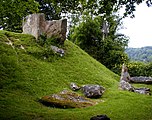Wikipedia:Today's featured article/January 18, 2020
The Coldrum Long Barrow is a ruined British Early Neolithic chambered long barrow near the village of Trottiscliffe, Kent. Probably constructed in the fourth millennium BCE, it was built by pastoralist communities soon after the introduction of agriculture to Britain. Built out of earth and around fifty local sarsen-stone megaliths, the barrow consisted of a tumulus enclosed by kerb-stones. At the eastern end of the tumulus was a stone chamber containing the remains of at least seventeen human bodies, at least one of which had been dismembered before burial, potentially reflecting a tradition of excarnation and secondary burial. The long barrow later became dilapidated, possibly exacerbated through deliberate destruction by iconoclasts or treasure hunters. Local folklore associates the site with the burial of a prince and the countless stones motif. Excavations took place in the early 20th century, and in 1926, ownership was transferred to the National Trust. Entry is free, and the stones are the site of various modern Pagan rituals. (Full article...)

